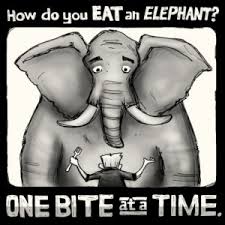
A school in crisis, a D rating on the state report card, disadvantaged students working below grade level, generational poverty, a culture of underperformance, a widely held view that the situation was hopeless - all of these were descriptions and perceptions of Whittemore Park Middle School a little over a year ago. The elephant in the room? Perhaps it was the unspoken belief that bringing about transformation and increasing student achievement and engagement in a public school in which nearly 90% of the children were children of poverty was impossible; perhaps it was the notion of some educational reformers that change can occur only if we could find the “right” teachers; perhaps the elephant was the weight of the public education system itself and the years of moving students through our factory model; perhaps it was all of these.
What gave us not only the will but also the tools to begin eating the elephant? These came from the awarding of a Next Generation Learning Challenges grant. The NGLC staff and network provided us with a cadre of colleagues eager to collaborate, willing to share honestly what didn’t work as well as what did, resources and access to experts-in-the-field to deepen our knowledge, and opportunities to accelerate our own learning with others who share our belief that our educational system can be transformed.
Our first bite was school wide implementation of a rotational model of blended learning. As teachers worked together in embedded professional development around blended learning and proficiency in using technology, we saw the first big shifts begin to take place. Teachers developed a deep collegiality, sharing what they were learning in their classrooms, taking risks, opening their classrooms to each other and to visitors to the school, and talking honestly not only about student learning but also about their own learning. We all learned the importance of establishing an environment in which we accept that innovation is often messy, uncomfortable, and non-linear. We have seen the development of teacher leadership, self-efficacy, and creativity as teachers have become “owners” of the model, making adaptations to schedules and classrooms and procedures and policies. We have also learned that there are times to stop chewing, to take a deep breath and celebrate what has been accomplished rather than all the work yet to be accomplished.
Our second bite, using daily data to inform instruction, came through providing 1:1 devices for students and through using Education Elements’ student and teacher dashboards to streamline access to digital content and data about student achievement. As teachers and students have become more proficient in using devices, content, and data, learning has become more personalized. Teachers are undertaking new roles as facilitators and coaches and are becoming adept in small group, sharply focused instruction. Students are daily developing more ownership in their learning, able to articulate what they have mastered and what help they need. Students are also becoming increasingly skilled collaborators, working in rotations on projects and products that require deeper levels of problem solving, creativity, and teamwork. Student attendance has increased, student discipline problems have decreased, and students in classrooms throughout the school are focused and engaged.
Have we eaten the elephant? Not yet – there are certainly still challenges ranging from technology issues in providing the needed infrastructure to support increased demands to creating a greater sense of urgency for teachers, students, and parents.
Yet in one year, teachers have embraced a new model for learning, students are showing a year’s academic growth in half of a school year, the school has moved from a D to a B on the state report card, and parents and community members have become actively engaged in the life of the school.
How do you eat an elephant? One bite at a time! Bon appétit!




